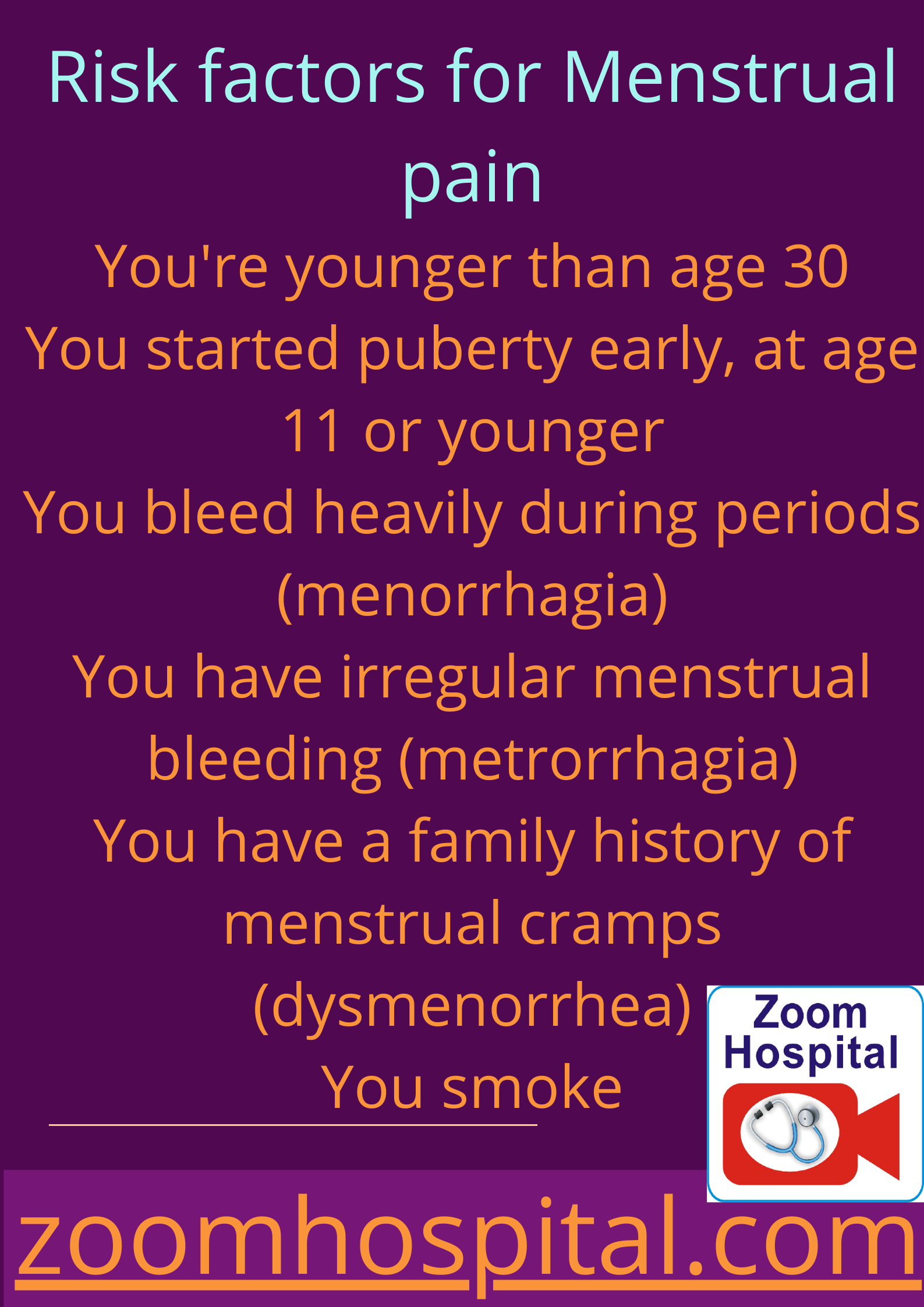You might be at risk of menstrual cramps if: You’re younger than age 30, You started puberty early, at age 11 or younger, You bleed heavily during periods (menorrhagia), You have irregular menstrual bleeding (metrorrhagia), You have a family history of menstrual cramps (dysmenorrhea), You smoke
Conditions such as endometriosis or uterine fibroid can cause menstrual cramps. Treating the cause is key to reducing the pain. Menstrual cramps that aren’t caused by another condition tend to lessen with age and often improve after giving birth.
Dysmenorrhoea is commoner in people with;

Risk factors for Menstrual pain
You might be at risk of menstrual cramps if:
You’re younger than age 30
You started puberty early, at age 11 or younger
You bleed heavily during periods (menorrhagia)
You have irregular menstrual bleeding (metrorrhagia)
You have a family history of menstrual cramps (dysmenorrhea)
You smoke
Symptoms of Menstrual pain
Symptoms of menstrual cramps include:
Throbbing or cramping pain in your lower abdomen that can be intense
Pain that starts 1 to 3 days before your period, peaks 24 hours after the onset of your period and subsides in 2 to 3 days
Dull, continuous ache
Pain that radiates to your lower back and thighs
Less common symptoms of Menstrual pain are ;
Nausea
Loose stools
Headache
Dizziness
When to see a doctor
Menstrual cramps disrupt your life every month
Your symptoms progressively worsen
You just started having severe menstrual cramps after age 25

Causes of Menstrual pain
The cause of menstrual pain can be Primary and secondary causes.
1. Primary causes of Menstrual pain are those things that causes menstrual pain when uterus is normal
During your menstrual period, your uterus contracts to help expel its lining. Hormonelike substances called prostaglandins are involved in pain and inflammation control. Prostaglandings trigger the uterine muscle contractions. The pain you experience during menses happen because of contractions in the uterus, or womb, which is a muscle tissue. If it contracts too strong during your menstrual cycle, it can press against nearby blood vessels. This briefly reduce supply of oxygen to the uterus. It’s this reduction of oxygen that causes your pain and cramping.Higher levels of prostaglandins are associated with more severe menstrual cramps.
2. Secondary Causes Menstrual pain
Menstrual cramps can be caused by other disease conditions:
Endometriosis. The tissue that lines your uterus becomes implanted outside your uterus, most commonly on your fallopian tubes, ovaries or the tissue lining your pelvis.
Uterine fibroids. These noncancerous growths in the wall of the uterus can cause pain.
Adenomyosis. The tissue that lines your uterus begins to grow into the muscular walls of the uterus.
Pelvic inflammatory disease. This infection of the female reproductive organs is usually caused by sexually transmitted bacteria.
Cervical stenosis. In some women, the opening of the cervix is small enough to impede menstrual flow, causing a painful increase of pressure within the uterus.
Abnormal uterus
Complications
Menstrual cramps don’t cause other medical complications, but they can interfere with school, work and social activities.
Certain conditions associated with menstrual cramps can have complications, though. For example, endometriosis can cause fertility problems. Pelvic inflammatory disease can scar your fallopian tubes, increasing the risk of a fertilized egg implanting outside of your uterus (ectopic pregnancy).
Menstrual Cramp Treatment
Heat can also help. Place a heating pad or hot water bottle on your lower back or tummy. A warm bath may also provide some relief.
Other lifestyle changes that may help:
Rest when you need it.
Avoid foods with caffeine and salt.
Avoid tobacco and alcohol.
Massage your lower back and abdomen.
Take dietary supplements.
Try to manage your stress.
Women who exercise regularly often have less menstrual pain. To help prevent cramps, make exercise a part of your weekly routine.
If these steps don’t do enough, tell your doctor